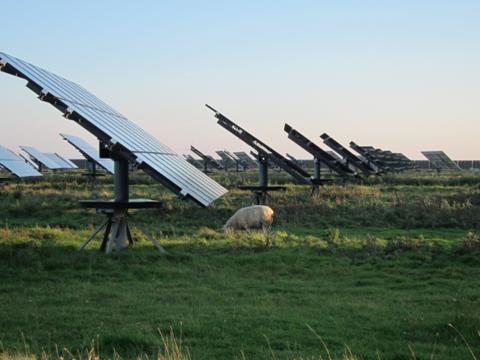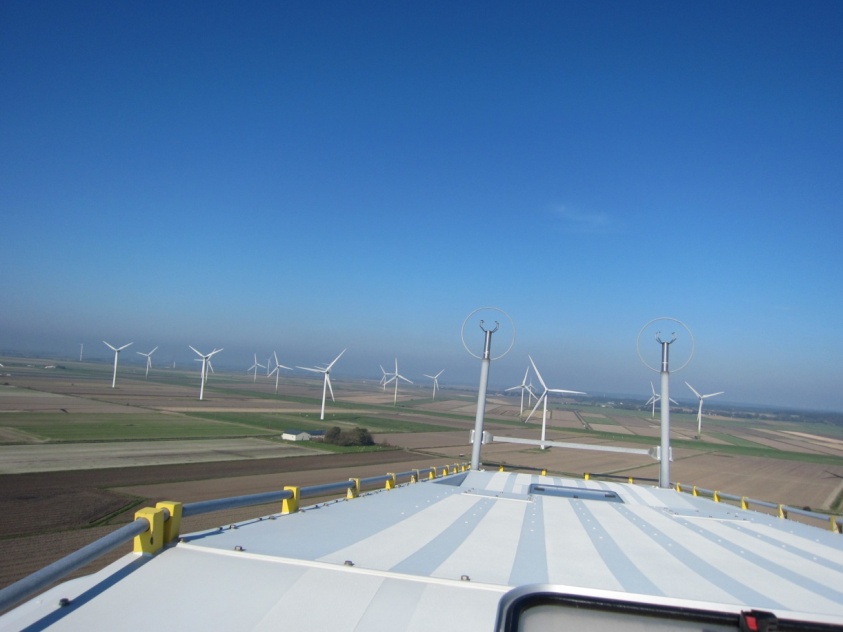Last fall, I participated in a clean energy/green jobs tour of Germany as part of a delegation sponsored by the Heinrich Böll Foundation and the Blue-Green Alliance. In the second leg of our trip (read my blog about part 1 of the tour), we left Berlin behind and headed north to the state of Schlesswig-Holstein—the renewable energy capital of the world.
Steve Clemmer, UCS Energy Research Director, also participated in the tour. So I asked him to provide his thoughts and insights on the region, and their successful approach to renewable energy development. Here is what Steve had to say:
“The landscape in Schlesswig-Holstein reminds me of my home state of Minnesota. Like Minnesota, the region is also a clean energy leader, generating about 60 percent of its current annual electricity needs from wind, solar, and biopower—one of the highest concentrations of renewable energy in the world.
 Nearly everywhere you go, you see wind turbines and solar photovoltaic (PV) panels on the rooftops of homes, businesses, barns, and in open fields. There are also several hundred small, efficient bioenergy facilities in the region, primarily converting corn into biogas and producing both electricity and heat for nearby communities.
Nearly everywhere you go, you see wind turbines and solar photovoltaic (PV) panels on the rooftops of homes, businesses, barns, and in open fields. There are also several hundred small, efficient bioenergy facilities in the region, primarily converting corn into biogas and producing both electricity and heat for nearby communities.
And they aren’t stopping there. The region is planning on tripling its land-based wind power capacity to 9,000 megawatts by 2020 by replacing older wind turbines with newer, more efficient machines and by building six new large offshore wind farms in the North Sea. In addition, solar PV continues to grow rapidly as costs fall, and the number of bioenergy facilities is expected to rise to 600 by 2012.”
Local Ownership: A Model for Success

Dirk Ketelsen, Executive Director of Dirkshof

The view from atop one of Dirk Ketelsen's wind turbines, one of the highlights from our trip to Schlesswig-Holstein.
Compared to the U.S., where most utility scale renewable energy facilities are owned by large companies, most facilities in Schlesswig-Holstein are locally owned. For example, we met with Dirk Ketelsen, originally an organic farmer, now Executive Director of Dirkshof, a multi-functional and energy focused company. Dirk took us on a tour of his 29 megawatt (MW) community-owned wind farm in Olderup (population 450). The total cost of the project was 50 million Euros – with 10 percent coming from 90 local shareholders, and the remainder financed by local banks. The shareholders receive 1.8 million Euros in annual payments, plus an additional 100,000 Euros for landowners who host the turbines. The project is eligible for Germany’s feed-in tariff, which requires utilities to provide a set payment of 9.5 cents per kilowatt-hour (kWh) of electricity produced from the project over a 10- to 20-year period.
We also visited a community-owned 2.6 MW solar PV facility, called Burgersolarpark, located in an open field right next to the North Sea. The project has 105 shareholders who invested $2.1 million, or about 20 percent of the total project cost. Frank Groneberg, who operates and maintains the facility, said that every dollar invested by the community is bringing $200 in income over the 20-year life of the project.
While Schlesswig-Holstein is currently reaping the economic and environmental benefits of renewable energy, they are also facing some of the same challenges we are facing in parts of the U.S. For example, the region has very limited transmission capacity and it has been difficult and time consuming to get new lines approved and built. As a result, Dirk Ketelsen’s wind project and many others have had to be curtailed or shut down during high wind periods.
On the flip side, it appears that it has been easier to site renewable energy projects in Germany. In addition to keeping more energy dollars in local communities, local ownership can make a big difference in overcoming siting, transmission, and integration barriers because the community has a vested interest in resolving these barriers and is more educated about the issues.

Our delegation and hosts at the Burgersolarpark in Northern Germany.
Renewable Electricity Standards and Feed-in Tariffs Can Work Well Together
Feed-in tariffs have been extremely effective in creating opportunities for local ownership of renewable energy projects. While a few U.S. states have adopted feed-in tariffs, it hasn’t gained much traction at the national level. However, feed-in tariffs could work well as a complement to the renewable electricity standards (RES) currently adopted in 29 states by providing homeowners, businesses, farmers, and entire communities with a stable, long-term revenue stream that is sufficient to own and finance projects. They could also be targeted at higher cost emerging technologies such as rooftop solar photovoltaics, biomass digesters on farms, or small wind turbines that often have trouble competing with large scale renewable energy projects under an RES.
In the final blog of this series, Steve and I will report on the last two legs of the tour: North-Rhine Westphalia, which is the industrial and coal mining center of Germany; and Brussels, Belgium, where the delegation met with European Union leaders and NGOs to discuss the region’s climate and energy policies.
